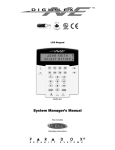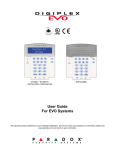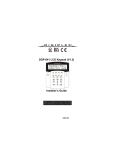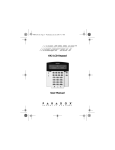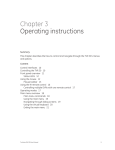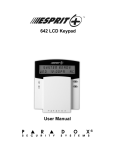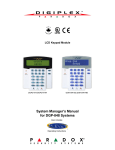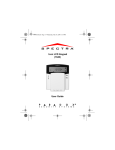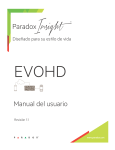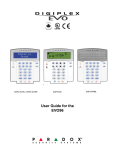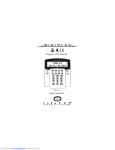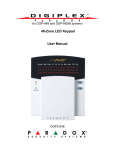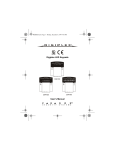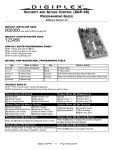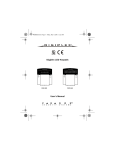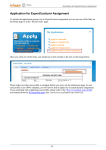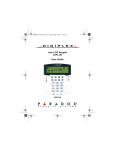Download DGP2-641 - DGP2-641BL - DGP2-641R - DGP2-641RB
Transcript
LCD Keypad DGP2-641B / DGP2-641RB DGP2-641 / DGP2-641R System Manager’s Manual Also includes Operating Instructions Table of Contents Introduction .................................................................. 1 Legend................................................................................. 1 Basic Operation ........................................................... 1 Auditory Feedback (Beep Tones)........................................ Confidential Mode................................................................ Partitioned System .............................................................. Area Status Display ............................................................. 1 2 2 2 Standard Fire Zone............................................................ Delayed Fire Zone ............................................................. Fire Safety Tips ................................................................. Minimizing Home Fire Hazards ......................................... Home Fire Warning System .............................................. Burglar Alarm..................................................................... 16 16 16 17 17 17 Arming .......................................................................... 2 Exit Delay Timer .................................................................. Regular Arming.................................................................... Stay Arming ......................................................................... Instant Arming ..................................................................... Force Arming ....................................................................... Bypass Programming .......................................................... One-Touch Buttons ............................................................. Keyswitch Arming ................................................................ Auto-Arming......................................................................... 2 2 3 3 3 3 4 4 4 Disarming ..................................................................... 4 Introduction ................................................................ 18 Access Codes ............................................................ 18 How Do I Use It?......................................................... 18 Things You Should Know ......................................... 18 When Accessing your InTouch... ....................................... 18 When Arming or Disarming... ............................................ 18 When Activating or Deactivating a PGM... ........................ 18 When Using your InTouch... .............................................. 19 Entry Delay Timer................................................................ 4 Disarming an Armed System............................................... 4 Alarm Memory Display ........................................................ 5 Telephone Button Features ...................................... 19 Access Codes .............................................................. 5 InTouch Example ....................................................... 19 System Master Code (Default 123456) ............................... 5 Find Next Free User ............................................................ 5 Copy User Options .............................................................. 6 User Labels ......................................................................... 6 Deleting User Access Codes............................................... 7 Programming User Access Codes ...................................... 7 User Options........................................................................ 9 Access Control User Options ............................................ 10 Using Access Control................................................ 11 Entering & Exiting .............................................................. 11 Arming and Disarming with Card....................................... 11 How Access Control Works ............................................... 12 Trouble Display .......................................................... 13 Event Record Display ........................................................ 13 Additional Features ................................................... 14 Programmable Outputs (PGMs) ........................................ Keypad Settings ................................................................ Set Time & Date ................................................................ Programming Chime Zones............................................... Panic Alarms ..................................................................... Quick Function Buttons ..................................................... 14 14 14 15 15 15 Testing and Maintenance .......................................... 15 Burglar Alarm Testing........................................................ Fire Alarm Testing ............................................................. System Maintenance ......................................................... System Test....................................................................... 15 16 16 16 Fire and Burglar Alarms ............................................ 16 InTouch System Checklist ........................................ 20 Appendix 1: Hebrew Special Characters ................. 21 Appendix 2: Russian Special Characters ................ 22 Index ........................................................................... 23 1.0 Introduction Your Digiplex DGP-NE96 System is an advanced technology security system that will provide you with reliable security protection and powerful features that are easy to use. The elegant and user-friendly LCD keypad will allow you easy access to your security system's functions and information at the touch of a button. The 32-character LCD screen will display messages and menus to guide you through the system’s operations. Your installer can even customize the messages for your home or business. Since you will communicate your instructions to your system through the keypad, please read this manual carefully and have your installer explain basic system operation. If you have the InTouch Voice Assisted Arm/Disarm Module (APR3-ADM2) connected to your DGP-NE96 system, please refer to page 18 for operating instructions. 1.1 Legend Indicates a warning or an important note. Indicates useful information or a tip. [SQUARE BRACKETS] Indicates information that must be entered on the keypad. 2.0 Basic Operation The following sections will introduce you to the roles of the buttons, lights, and messages on your LCD keypad. Figure 1: Basic Overview AC Light: ON = AC power OFF = Power failure STATUS Light: When Green: ON = All zones are closed. OFF = One or more zones are open. FLASH = Exit Delay When Red: ON = Area(s) armed OFF = Area(s) disarmed FLASH = System in Alarm The LCD screen will guide you with detailed messages. Use the arrow buttons to scroll through the current menu when the arrows appear in the LCD screen. Action Buttons: Each button’s function is explained in the following sections of the manual. [CLEAR] = Erases current data entry or reverts to the preceding step. 2.1 [ENTER] = Saves current data and exits current menu. Auditory Feedback (Beep Tones) When you enter information on the keypad, the keypad will guide you with beep tones to communicate the acceptance or rejection of your entries. Confirmation Beep: When an operation (i.e. arming/disarming) is successfully entered or when the system switches to a new status/mode, the keypad emits an intermittent beep tone (“BEEP-BEEP-BEEP-BEEP-BEEP”). Rejection Beep: When the system reverts to a previous status, or when an operation is incorrectly entered, the keypad emits a continuous beep tone (“BEEEEEEEEEEP”). LCD Keypad 1 2.2 Confidential Mode Your installer can program keypads to not display the status of your system automatically by changing the LCD screen to Confidential Mode. In Confidential Mode: • The zones and status messages will NOT be displayed • The indicator lights will NOT illuminate • Depending on how your keypad was programmed by your installer, you must either press a button or enter your user access code to illuminate the indicator lights and activate Normal Mode. 2.3 Partitioned System A separated system is called a Partitioned System, which can be useful in situations where shared security systems are more practical. Your installer can design your system to recognize up to eight separate protected areas. For example, a company that has both an office area and a warehouse area can arm and disarm each area separately and control the access to each area. If you have access to more than one area, and you need to select a specific area(s) when prompted by your LCD keypad, follow either one of the following three methods to make your selection: • Press the keypad button corresponding to the area you wish to select (i.e. 1, 2,...8). • Press the [0] button for all areas. • Use the [S] and [T] buttons, and press [ENTER] when the area you want to select appears on the screen. 2.4 Area Status Display The Area Status Display allows you to view the status of the selected areas in a Partitioned System (for more information, see section 2.3 on page 2). To view the status of the areas: 1. Enter your [ACCESS CODE], and then press the [1] button. 2. Press the button corresponding to the area (i.e. 1, 2,...8), or use the [S] and [T] buttons and press [ENTER] when the area you want to view appears on the screen. 3. Press [CLEAR] to exit. In Area Status Display mode, the following information will scroll on the LCD screen: • • • • • • ready: if all zones in the selected area are closed. not ready: if zones in the selected area are open. open zones within that area (i.e. Front Door Open). Trouble(s): (section 7.0 on page 13) if a trouble has occurred. Alarms in Memory: (section 4.3 on page 5) if an alarm has occurred. Armed; Force Armed; Instant Armed; Stay Armed: displays the arming status of the selected area. 3.0 Arming When your system is armed, it can respond to any breach in the protected zones by causing an alarm and sending a report to your monitoring station. 3.1 Exit Delay Timer When you arm your system, it will trigger the Exit Delay Timer to provide you with enough time to exit the protected area before the system is armed. 3.2 Regular Arming This method is used for the everyday arming of your system. All zones within the protected area must be closed to Regular arm the system. To Regular arm the system: 1. Enter your [ACCESS CODE]. 2. Press the [ARM] button. 3. If you have access to more than one area, select the area(s) you wish to Regular arm (refer to section 2.3 on page 2). 2 User’s Manual 3.3 Stay Arming Stay arming will partially arm your system to permit you to remain in your home or office by arming the outer zones (perimeter) of the protected area (i.e. doors and windows). To Stay arm: 1. Enter your [ACCESS CODE]. 2. Press the [STAY] button. 3. If you have access to more than one area, select the area(s) you wish to Stay arm (refer to section 2.3 on page 2). 3.4 Instant Arming This feature is the same as Stay arming except that there is no Entry Delay. Therefore, any armed zone that is breached will immediately generate an alarm. To Instant arm: 1. Enter your [ACCESS CODE]. 2. Press the [5] button. 3. If you have access to more than one area, select the area(s) you wish to Instant arm (refer to section 2.3 on page 2). 3.5 Force Arming Force arming allows you to quickly arm your system when zones are open. However, once the open zone is closed, your system will then arm that zone as well. To Force arm: 1. Enter your [ACCESS CODE]. 2. Press the [FORCE] button. If you have access to more than one area, select the area(s) you wish to Force arm (refer to section 2.3 on page 2). 3.6 Bypass Programming You can bypass certain zones when you arm the protected area(s). When a zone is bypassed, it will be ignored the next time your system is armed. Once your area is disarmed, the system will unbypass the zone. To Bypass a zone: 1. Enter your [ACCESS CODE]. 2. Press the [BYP] button. 3. Enter the zone number (i.e. 01, 02,...96), or use the [S] and [T] buttons and press [BYP] once the zone you want to bypass appears on the screen. If bypassed does not appear on the screen and the keypad emits a rejection beep, you may not have access to bypass that zone. 4. Repeat step 3 until all zones you want to bypass have been selected. 5. Press the [ENTER] button to save and exit. In order to bypass a zone, the following conditions must be met: • The zone must have the Bypass option programmed by your installer. • The Bypass option must be enabled in your User Options. • Your user access code must have access to the zone’s Area Assignment. • The zone’s area must be disarmed before the zone can be bypassed. Fire Zones cannot be bypassed. 3.6.1 Bypass Recall Bypass Recall reinstates the zones that were bypassed the last time your system was armed. To activate Bypass Recall: 1. Enter your [ACCESS CODE]. 2. Press the [BYP] button. 3. Press the [MEM] button. Zones bypassed the last time your system was armed are bypassed. 4. Press the [ENTER] button to save and exit. LCD Keypad 3 3.7 One-Touch Buttons If enabled by your installer, you can access the following features without using your user access code by pressing and holding the desired One-Touch button. 3.8 Button Feature Button Feature [ARM] Regular arm [DISARM] Disarm a Stay/Instant armed area [STAY] Stay arm [5] Instant arm [FORCE] Force arm [6] Change display settings [BYP] Bypass Programming [7] View Event Record display Keyswitch Arming A key can be used to arm and disarm your system using two forms of keyswitches. With a Maintained Keyswitch, place the key in the “ON” position to arm your system, and place the key in the “OFF” position to disarm your system. With a Momentary Keyswitch, place the key in the “ON” position briefly then place it back in the “OFF” position to arm the system. Repeat this process to disarm with a Momentary Keyswitch. 3.9 Auto-Arming If enabled by your installer, you can set the time that an area will arm itself automatically. 3.9.1 Timed Auto-Arming Your installer can set Timed Auto-Arming to function in either Force or Stay arming mode. A sixty-second Exit Delay sequence will begin prior to your system automatically arming itself at the programmed time. To set the Auto-Arming timer: 1. Enter your [ACCESS CODE]. 2. Press the [0] button. 3. Press the [MEM] button. 4. If you have access to more than one area, press the area’s number, or use the [S] and [T] buttons and press the [ACC] button when the area you want to program appears on the screen. 5. Enter the time you want the area to be armed according to the 24-hour clock (i.e. 9 a.m. is 09:00 and 9 p.m. is 21:00). 6. Press the [ENTER] button to save and exit. 3.9.2 No Movement Auto-Arming Your system can be programmed to send a report to your monitoring station and/or arm the system if there is no activity in the area during a specified period of time. Your installer can set No Movement AutoArming to function in either Regular or Stay arming mode. 4.0 Disarming When your system is disarmed, it deactivates any alarms in progress, and it deactivates the zones so the alarm will not be triggered if zones are breached. 4.1 Entry Delay Timer Your installer will program designated entry points (i.e. the front door) with an Entry Delay Timer. This delay gives you time to enter the armed premises and enter your code to disarm your system before the alarm is triggered. 4.2 Disarming an Armed System You can only disarm an area to which your user access code is assigned. User access codes with the “Arm Only” (section 5.7 on page 9) option enabled cannot disarm an armed system. How do I disarm the system? 1. Enter your [ACCESS CODE]. 2. Press the [DISARM] button. If you have access to more than one area, select the area(s) you wish to disarm (refer to section 2.3 on page 2). 4 User’s Manual To disarm a system in alarm: 1. Enter your [ACCESS CODE]. 2. In the case of a false alarm, call your monitoring station quickly to advise them of the false alarm. In the case of a burglar alarm, leave the premises and call the Police from a safe place. 4.3 Alarm Memory Display Your system will record all the alarms that occurred during the last armed period. The zones in alarm will remain in the Alarm Memory until the next time that area is armed. How do I view the list of alarms that occurred? 1. When an alarm has occurred, the LCD screen will display Alarms in Memory [mem] to View. 2. Press the [MEM] button. Each zone that was breached while armed will appear below Alarm in:. 3. Press the [CLEAR] button to exit the Alarm Memory Display. 5.0 Access Codes Access Codes allow access to the system. Your system supports up to 999 user access codes. Codes are given a User Number between 002 and 999 (User Number 001 is the System Master Code). Your installer will program user access codes to be four, six, or variables of one to six digits in length. Each digit can be any value between zero and nine. If your installer programmed your system to accept a variable code length, you have to press the [ENTER] button after entering your user access code. 5.1 System Master Code (Default 123456) The System Master Code will give you access to all the features available on your system, as well as the ability to add, modify, or delete any user access codes. We suggest that you change this code to prevent others from accessing and changing options without authorization. Your installer can set the System Master Code to be either 4 or 6 digits in length. To change the System Master Code: 1. Enter the current [ACCESS CODE] (default: 123456). 2. Press the [0] button. 3. Press the [ACC] button. 4. Enter the numbers [0] [0] and [1]. 5. Enter a [NEW CODE]. 6. Press the [ENTER] button to save and exit. The System Master Code has access to all Access Control doors and all Access Control features at all times. Only the card’s serial number and the choice of arming method can be changed. If the other options are manually changed, the System Master Code will immediately revert to its original programming. You can assign a label (name) to a user access code at any point during the “programming User Access Code” process. Refer to section 5.4 on page 6 to assign a User Label. 5.2 Find Next Free User This feature automatically searches your system for the next available unassigned user access code. To find the next free user: 1. Enter your [ACCESS CODE] (System Master Code or user access code with Master feature). 2. Press the [0] button, and then the [ACC] button. 3. Press the [BYP] button. 4. Program the user access code as detailed in Figure 2 on page 8 starting from step 5. LCD Keypad 5 5.3 Copy User Options This feature allows you to copy the User Options, Access Control Options, and Area Assignments from one user access code to another. All User Options are copied except the User Code, Card Assignment, and User Label. To copy user options: 1. Enter your [ACCESS CODE] (System Master Code or user access code with Master feature). 2. Press the [0] button, and then the [ACC] button. 3. Enter the 3-digit User number you wish to copy TO. 4. Press the [MEM] button. 5. Enter the 3-digit User number you wish to copy FROM. 6. Enter a user code. If the user code is of variable length, press the [ENTER] button after entering the user code. If necessary, assign an Access card (step 10 in Figure 2 on page 8) and User Label (section 5.4 on page 6). 7. Press [ENTER] to save and exit. 5.4 User Labels User labels personalize user access codes and can be assigned by pressing [ENTER] at any point after step 4 during the programming of user access codes (Figure 2 on page 8). For Example, the LCD keypad can display John Smith Select Action. To program a user label: 1. At any point after step 4 in Figure 2 on page 8: 2. Press the [ENTER] button. 3. Type the desired characters as detailed in section 5.4.1 on page 6 and section 5.4.2 on page 6. 4. Press the [S] button to move the cursor to a new space. 5. Repeat steps 2 and 3 until the desired label is complete. 6. Press the [ENTER] button to save and exit. 5.4.1 Keypad Buttons Every numeric button on your LCD keypad is assigned a set of letters. To obtain the desired letter using the numeric buttons on your keypad, press the button until the desired letter appears on the screen. For example, if you wanted to enter the letter “C” you would press the [1] button three times (refer to Table 1 on page 6). If using a Hebrew keypad, refer to Table 4 in Appendix 1: Hebrew Special Characters on page 20. If using a Russian keypad, refer to Table 6 in Appendix 2: Russian Special Characters on page 21. Table 1: Keypad Letter Assignments Key 5.4.2 Press Key Once Press Key Twice Press Key Three Times [1] A B C [2] D E F [3] G H I [4] J K L [5] M N O [6] P Q R [7] S T U [8] V W X [9] Y Z Special Function Keys [STAY] = Insert Space Pressing the [STAY] key inserts a blank space in the current cursor position. [FORCE] = Delete Pressing the [FORCE] key will delete the character or blank space found at the current cursor position. [ARM] = Delete Until the End Pressing the [ARM] key will delete all characters and spaces to the right of the cursor and at the cursor's position. 6 User’s Manual [DISARM] = Numeric Keys / Alphanumeric Keys Every time the [DISARM] key is pressed it will toggle from numeric keys to alphanumeric keys and vice versa. Numeric: Keys [0] to [9] represent numbers 0 to 9. [BYP] = Lower Case / Upper Case Every time the [BYP] key is pressed it will toggle the case setting from lower to upper case and vice versa. [MEM] = Special Characters After pressing the [MEM] key, the cursor will turn into a flashing black square. Using Table 2 on page 7, enter the 3-digit number that represents the desired symbol. If using a Hebrew keypad, refer to Table 5 in Appendix 1: Hebrew Special Characters on page 20. If using a Russian keypad, refer to Table 7 in Appendix 2: Russian Special Characters on page 21. Please note that the DGP2-641B and DGP2-641RB keypads do not support Hebrew, Russian, Greek or Lithuanian character sets. Table 2: Special Characters Catalogue 5.5 Deleting User Access Codes To delete user access codes, follow steps 1 to 5 in Figure 2 on page 8, but press the [CLEAR] button in Step 5. Once the information is erased, press the [ENTER] button to save and exit. 5.6 Programming User Access Codes The System Master and Users with the Master feature can program user access codes with User Options and Area Assignments. Figure 2 on page 8 describes the steps you would follow to program user access codes. If you wish to program user access codes using the NEware Software, please contact your installer for information. If the keypad emits a rejection beep at any point during the programming procedure, you may have chosen an existing user code or you do not have access to certain User Options (section 5.7) and Area Assignments (step 7 in Figure 2 on page 8). Users with the Master feature can only assign User Options and Area Assignments that they are assigned to. For example, if a User with the Master feature is assigned User Option 1 and Area 2, they can only assign Options 1 and Area 2 to a user access code. LCD Keypad 7 Figure 2: Programming User Access Codes Enter your [ACCESS CODE] (System Master Code or user access code with Master feature). Press [0] to enter the Programming Menu. From Programming Menu, press [ACC]. Enter the 3-digit User Number you want to program; press the [T] button to scroll the list of codes and then press [ACC] once the desired code appears on the screen; or to “Find Next Free User” press the [BYP] button (refer to section 5.2 on page 5). Enter a user code within the brackets. If the user code is of variable length, press the [ENTER] button after entering the user code. Press the [S] button to reach the User Options screen. NOTE: The user code is a Personal Identification Number (P.I.N.). Program the User Options by pressing the number on your keypad corresponding to the User Option you wish to enable. The option is considered ON when the number appears within the brackets. Proceed to step 7 by pressing the [S] button. For a detailed description of the User Options refer to section 5.7 on page 9. Options [1] and [2]: Master Feature [1] OFF = Master Feature disabled. [1] ON, [2] OFF = User Can create and modify user access codes and User labels only. [1] ON, [2] ON = User has full Master rights. User can create, modify, and program User options, User Access Options and Area Assignments. Option [3]: Duress Option [4]: Bypass Option [5]: Arm Only Option [6]: Stay and Instant Arm Option [7]: Force Arm Option [8]: OFF - Access keypad’s partitions only ON - Access any partition assigned to user Users are able to perform actions (arming, disarming, etc.) only in the area(s) they are assigned. To assign an area(s) to a user access code, enter the number corresponding to the area you wish to assign (i.e. [1] = area 1, ...[8] = area 8). Press the [T] button to return to the User Options; press the [S] button to proceed to step 8; or press the [ENTER] button to save and exit programming mode. NOTE: If no area is assigned, and if PGMs are programmed by your installer, the user can only control the PGMs. Refer to section 8.1 on page 14 for a more detailed explanation of PGMs. 8 User’s Manual A) Enter the 2-digit Access Level (i.e. 00, 01,...15) within the first set of brackets. An Access Level determines which Access Control doors a User is allowed to pass through. There are 16 possible Access Levels which are usually programmed by your installer. If you wish to program the Access Levels yourself, you will need the NEware Software which is available through your installer. Access to all Access Control doors is Access Level 00. B) Enter the 2-digit Schedule (i.e. 00, 01,...15) in the second set of brackets. Schedules, programmed by your installer, determine the hours, days, and holidays that Users are permitted through Access Control doors. Each user is assigned a Schedule through the user access code. To provide access at all times, assign Schedule 00. Program the Access Control User Options by pressing the number on your keypad that corresponds to the Option you wish to assign. The option is considered ON when the number appears within the brackets. For a detailed description of the User Access Control Options, refer to section 5.8 on page 10. Press the [S] button to proceed to step 10. Option [1]: Access Control Option [2]: Can Disarm with Access Card Option [3]: Extended Unlocked Period Options [4] and [5]: Arming with Card [4] ON, [5] OFF = Regular Arm [4] OFF, [5] ON = Stay Arm [4] and [5] ON = Force Arm [4] and [5] OFF = Disable the Arming with Card feature Option [6]: Add Tolerance Window to Schedule Option [7]: Code Follows Schedule Option [8]: Card to Unlock and Code to Disarm Enter the Access Control card’s serial number within the brackets. Press the [ENTER] button to save and exit. 5.7 User Options Options [1] and [2]: Master Feature When option [1] is OFF, the User cannot program other users into the system. When option [1] is ON and option [2] is OFF, the user can program and modify user access codes (P.I.N. only) and User Labels. When both options [1] and [2] are ON, the user has Full Master rights. The user can create or modify user access codes, User Options, User Access Control Options, Access Card Numbers, User Labels and Area Assignments according to their own programming. For example, if the Full Master User has access to area #1 and option [4] (Bypass) only, the Full Master user can only assign area #1 and option [4] to other users in the system. Option [3]: Duress When option [3] is ON, the Duress feature is enabled. This feature is used when someone forces a user to arm or disarm an area(s). By entering a user access code (P.I.N.) reserved for the Duress feature, the system will arm or disarm the area(s), and then send a silent alarm to the monitoring station. Option [4]: Bypass When option [4] is ON, the Bypass feature is enabled. This feature allows the user to deactivate zones when arming the area(s). Option [5]: Arm Only When option [5] is ON, the Arm Only feature is enabled. The user can arm assigned areas with either a card or LCD Keypad 9 code, but cannot disarm. When the option is OFF, the user can either arm or disarm assigned areas. Option [6]: Stay & Instant Arm When option [6] is ON, the Stay and Instant arm features are enabled. The user can now Stay or Instant arm their assigned areas. Option [7]: Force Arm When option [7] is ON, the Force arm feature is enabled. The user can now Force arm their assigned areas. Option [8]: Area Access When option [8] is ON, the keypad will permit access to all the areas assigned to the user access code. When option [8] is OFF, the keypad will only permit access to the areas it controls. For example, the keypad is assigned area 1 only, and your user access code is assigned areas 1 to 8. If the option is ON, you can access all eight areas from the keypad. If the option is OFF, you can only access area 1. By default all users can Regular arm the system. 5.8 Access Control User Options Option [1]: Access Control When option [1] is ON, the user can gain access to an access control door when Access Control is enabled in the system. A user that is not assigned to any partition, but has the Access Control option (Option [1]) enabled, can now gain access to an access control door by entering a code # (P.I.N.) and then pressing the [ACC] keypad key. When the option is OFF, the user cannot access an Access Control door. Option [2]: Can Disarm with Access Card When option [2] is ON, a User’s Access Control card can unlock and disarm an armed Access Control door. When option [2] is OFF, follow the settings in option [8] on page 11. For option [2] to function in the ON position, option [5] “Arm Only” in the User Options must be disabled (refer to section 5.7 on page 9). Option [3]: Card with Extended Unlocked Period When option [3] is ON, “Extended Unlocked Period” is enabled. “Extended Unlocked Period” refers to the time period programmed into each Access Control door by your installer that extends the unlocked time of the door. For example, if your installer sets the Unlocked period of the door to 30 seconds and the Extended Unlocked Period to 15 seconds, a user access code with “Extended Unlocked Period” enabled will have a total of 45 seconds to pass through the door. Options [4] and [5]: Arming with Card Options [4] and [5] define the type of arming when arming with an Access Control card (refer to section 6.2.1 on page 11). You can either Regular arm, Stay arm, Force arm, or Disable the Arming with Card feature. [4] ON, [5] OFF = Regular Arm [4] OFF, [5] ON = Stay Arm [4] and [5] ON = Force Arm [4] and [5] OFF = Disable the Arming with Card feature Option [6]: Add Tolerance Window to Schedule When option [6] is ON, the Schedule Tolerance Window feature is enabled. This feature extends a user’s scheduled access period through an Access Control door by the amount programmed by your installer. For example, if the user’s assigned schedule for the door is Monday to Friday from 9:00 a.m. to 5:00 p.m., and your installer sets the “Tolerance Window” at one hour, the user with the “Schedule Tolerance Window” enabled will be able to enter and exit one hour before and after their scheduled time for that door. Option [7]: Code Follows Schedule When option [7] is ON, users can use their access codes only during their scheduled hours assigned in step 8 in Figure 2 on page 8. When the option is OFF, users can use their access codes at any time. Option [8]: Card to Unlock and Code to Disarm Option [8] functions only if option [2] in section 5.8 is OFF. When option [8] is ON, a user can use an Access Control card to unlock an armed Access Control door, however the user must enter a user access code to disarm the armed area. When option [8] is OFF, a user can gain access to an Access Control door only if the door’s area(s) is already disarmed. For option [8] to function in the ON position, option [5] “Arm Only” in the User Options must be disabled (refer to section 5.7 on page 9). 10 User’s Manual 6.0 Using Access Control 6.1 Entering & Exiting Depending on how your system is installed, there are various ways to enter and exit Access Control doors: • Present your Access Control card to the reader or the DGP2-641R/DGP-641RB keypad. The system will verify that the card is allowed access according to its assigned Access Level and Schedule. If it is accepted, the system will unlock the door. The reader’s light can be programmed by the installer to turn green or extinguish briefly to indicate that the door can be opened. • When the motion detector detects movement (Request for Exit), it will unlock the door to permit passage from inside. • Enter your user access code on the keypad and press [ACC]. • If the Access Control door is on a “Door Unlocked Schedule”, you may be able to open Access Control doors without using a user access code or an Access Control card. Depending on the door’s programming, the door can remain unlocked during the entire programmed schedule or the door can unlock once a valid Access Control card is presented to the reader during the schedule and then will remain unlocked for the remainder of the schedule. 6.2 Arming and Disarming with Card 6.2.1 Arming with Card An Access Control card can be programmed to arm areas assigned to the door when it is presented to the reader or DGP2-641R/DGP2-641RB keypad (door) twice within approximately 5 seconds without opening the door. The Access Control card must be: • • • • 6.2.2 presented to a door during its assigned Schedule (refer to step 8 in Figure 2 on page 8). presented to a door within its assigned Access Level (refer to step 8 in Figure 2 on page 8). programmed to allow arming (options [4] and [5] in section 5.8 on page 10). assigned to all areas that are assigned to the Access Control door (refer to step 7 in Figure 2 on page 8), or assigned to at least one of the areas assigned to the Access Control door depending on how your installer has programmed the Access Control door. Disarming with Card To disarm and unlock an Access Control door when the area assigned to it is armed, present your Access Control card to the reader or DGP2-641R/DGP2-641RB keypad (door). The Access Control card must be: • • • • presented to a door during its assigned Schedule (refer to step 8 in Figure 2 on page 8). presented to a door within its assigned Access Level (refer to step 8 in Figure 2 on page 8). programmed to allow disarming (option [2] in section 5.8 on page 10). assigned to all areas that are assigned to the Access Control door (refer to step 7 in Figure 2 on page 8), or assigned to at least one of the areas assigned to the Access Control door depending on how your installer has programmed the Access Control door. LCD Keypad 11 6.3 How Access Control Works To illustrate how Access Control functions, we will use three simple Access Control System examples: Figure 3: Example A Bonnie’s Access Control card is programmed with Access Level 01 and Schedule 01. If she presents her card to the reader or the DGP2-641R/DGP2641RB keypad on Door 02 on Tuesday, August 3 at 3:00 p.m., she will gain access to the room. Figure 4: Example B If Bonnie presents her card to the reader or the DGP2-641R/DGP2641RB keypad on Door 02 on Saturday or on a Holiday at 3:00 p.m., she will be denied access. Figure 5: Example C If we change Bonnie’s Access Level to 02 and she presents her card to the reader or the DGP2641R/DGP2-641RB keypad on Door 02 on Tuesday, August 3 at 3:00 p.m., she will be denied access. 12 User’s Manual 7.0 Trouble Display If your system experiences any problems, Trouble(s) [TRBL] to View will appear on the screen. The Trouble Display will only display the troubles that occur in the area(s) to which the keypad has been assigned. Potential troubles have been sorted into eight groups. Only the troubles which are relevant to you are listed and described below. If a trouble that is not described or listed below appears, contact your installer. To view the Trouble Display: 1. Press the [TRBL] button when Trouble(s) [TRBL] to View appears on the screen. The Group Heading with the trouble will appear on the screen. 2. Press the [S] and [T] buttons to scroll between the Groups experiencing a trouble. 3. Press the [NUMBER] of the Trouble you wish to view. We strongly suggest that if any troubles occur, contact your installer immediately to have your system serviced. 7.0.1 Group 1: System [1] AC Failure The control panel has detected a power failure. This means that your system is running on the backup battery. If this trouble occurs when your establishment is not experiencing a power failure, call your installer for repairs. [2] Battery Trouble The backup battery is disconnected, needs to be recharged, or replaced. [5] Bell Absent The system has detected that the bell or siren is not connected. 7.0.2 Group 2: Communicator [1] TLM1 The control panel is unable to access the main telephone line. [2] to [5] Fail to Communicate (1 to 4) The control panel tried all assigned telephone numbers and failed to contact the monitoring station. [6] Fail to Communicate PC The control panel is unable to communicate with the WinLoad software. 7.0.3 Group 5: Zone Tamper The zone(s) that was tampered with will be displayed on the LCD screen. 7.0.4 Group 6: Zone Low Battery If a wireless device's battery needs to be replaced, the zone that is assigned to the device will be displayed on the LCD screen. 7.0.5 Group 7: Zone Fault A wireless device is no longer communicating with its receiver, or a connection or CleanMeTM trouble is occurring with your smoke detectors. 7.0.6 Group 8: Clock Loss The time and date have been reset to the default. This is the only trouble that we recommend that you correct. Clock Loss [8] to Set will appear on the LCD screen after you press the [TRBL] button. Refer to section 8.3 on page 14 to set the time and date. 7.1 Event Record Display The Event Record Display will record the user-initiated actions that occurred in your system as well as any alarms or troubles (i.e. “Access Granted”). You will only be able to view the events that occurred in the area(s) assigned to your user access code. LCD Keypad 13 To view the Event Record: 1. Enter your [ACCESS CODE]. 2. Press the [7] button. 3. If you have access to more than one area, select the area(s) you wish to view (refer to section 2.3 on page 2). 4. Use the [S] and [T] buttons to scroll between the events. 5. Press the [CLEAR] button to exit. Once you have entered Event Record Display mode, you can change the order that the Event Record screens appear by pressing the [7] button. If you already know the number of the event you want to view, press the [MEM] button after step 3 above, and then enter the event's number. 8.0 Additional Features 8.1 Programmable Outputs (PGMs) Your system includes Programmable Outputs (PGMs) that can be programmed by your installer. A PGM triggers when a predetermined event or series of events occurs in your system. The PGMs can be programmed to reset smoke alarms, turn on light switches, open or close garage doors and much more. Ask your installer about this useful feature. 8.2 Keypad Settings You can modify the keypad settings to suit your needs (Refer to Figure 6 on page 14). 1. Scrolling Speed refers to the amount of time that a message will remain on the screen before moving to the next message. 2. Backlight refers to the illumination behind the buttons and LCD screen. 3. Contrast refers to how dark or pale characters will appear on the screen. Figure 6: Modifying LCD screen settings 8.3 Set Time & Date To reset the time and date: 1. Enter your [ACCESS CODE] and press the [TRBL] button. 2. Press the [8] button. 3. To change the time, place the cursor under the number you want to change by using the [S] button and enter the time according to a 24-hour clock (i.e. 9 a.m. is 09:00 and 9 p.m. is 21:00). 4. To change the date, place the cursor under the number you want to change and enter the correct date according to year/month/day. 5. Press the [ENTER] button to save and exit. 14 User’s Manual 8.4 Programming Chime Zones You can program the keypad to emit a rapid, intermittent beep tone whenever designated zones are opened or only when opened between certain hours. These zones are referred to as Chime Zones. Your installer can also program your Chime zones to beep upon closure. How do I program chime zones? 1. Enter your [ACCESS CODE]. 2. Press the [9] button. 3. Press the [1] button to chime a zone. Enter the number corresponding to the zone to be chimed, or use the [S] and [T] buttons to scroll the list of zones. Press the [ACC] button to chime or unchime the zone that appears on the screen. Press [ENTER] to save. OR Press the [2] button to set the time period a chimed zone will beep. Enter the time that the chimed zone(s) will start beeping when opened (HH:MM). Enter the time that the chimed zone(s) will stop beeping when opened (HH:MM). 4. Press [CLEAR] to exit chime programming. 8.5 Panic Alarms Your system can be programmed to send an alarm to your monitoring station to request help from the police, a medical facility, the fire department, or anyone you wish when you press a predetermined combination of buttons. To generate a panic alarm, simultaneously press and hold the button combinations displayed in Table 3 on page 15. Your installer can program the alarm to be either silent or audible. Table 3: Panic Buttons Panic Alarm Types 8.6 Buttons to be pressed and held simultaneously Emergency Panic Press & hold the [1] and [3] buttons Auxiliary Panic Press & hold the [4] and [6] buttons Fire Panic Press & hold the [7] and [9] buttons Quick Function Buttons You will only need to use the Quick Function Buttons upon your installer’s or monitoring station's request. Only the System Master Code or user access codes with the Master feature enabled will be able to access these functions. To access the Quick Function Buttons: 1. Enter your [ACCESS CODE] 2. Press the [0] button. 3. Press the: [STAY] button to send a test report to the monitoring station. [FORCE] button to call the WinLoad software. [ARM] button to answer the WinLoad software. [DISARM] button to cancel communication with the WinLoad software. 9.0 Testing and Maintenance 9.1 Burglar Alarm Testing Two people are needed to complete this test. One person will watch the LCD screen on the keypad while the other person walks around the protected areas and opens the zones (i.e. opens the doors and windows that are protected, walk in the path of the motion detectors, etc.). The LCD screen will display the opened zones, but if a zone does not register, contact your installer. 9.2 Fire Alarm Testing Do NOT use an open flame or burning materials to test your fire detection devices. Your installer will provide details on the best way to test your system. LCD Keypad 15 9.3 System Maintenance Under normal use your system requires no maintenance other than regular testing. We recommend that your installer change the battery every three years. 9.4 System Test Speak to your installer before conducting a System Test since the system must be programmed to respond to the test instructions. It is normally recommended that you conduct the system test once a week, but contact your installer for instructions concerning your particular system. To conduct the system test: 1. Call your monitoring station to advise them that you are testing your system. 2. Enter your [ACCESS CODE]. 3. Press the [8] button. The system will test all its connections and can send a report to your monitoring station. If the system detects a problem, the Trouble Display will show on the LCD screen (refer to section 7.0 on page 13). Call your installer for repairs if any troubles occur. 10.0 Fire and Burglar Alarms 10.1 Standard Fire Zone During a fire alarm, the bell/siren emits an intermittent sound (BEEP-BEEP-BEEP) until silenced or reset. If the zone is a Standard Fire Zone, your system can immediately send an alert to your monitoring station. To disarm a false alarm: 1. Enter your [ACCESS CODE] on the keypad. 2. Call your monitoring station quickly to advise them of the false alarm. The Fire Zone may reset itself once the problem has cleared. If it does not, simultaneously press and hold the [CLEAR] and [ENTER] buttons for two seconds. 10.2 Delayed Fire Zone If the zone is a Delayed Fire Zone, there is an automatic delay before your system contacts your monitoring station. Refer to Figure 7 on page 17 to prevent unnecessary reporting of false alarms. If the fire alarm is accidentally triggered: 1. Press the [CLEAR] button within 30 seconds of the alarm. 2. Clear the problem from the area (i.e. clear the smoke from around the smoke detector). 3. If the problem remains after 90 seconds, the alarm will sound again. Press [CLEAR] again. 4. The system will delay reporting the alert for another 30 seconds. If you are unable to cancel the false alarm, your system will send an alert. Call your monitoring station to advise them of the false alarm. The Fire Zone may reset itself once the smoke has cleared. If it does not, simultaneously press and hold the [CLEAR] and [ENTER] buttons for two seconds or speak to your installer. 10.3 Fire Safety Tips How should you prepare in case of a fire in your home or business? • • • • • • • • Remind everyone to escape first, and then call for help. Develop a fire escape plan and designate a meeting place outside. Practice the escape plan frequently. Plan two ways to escape from every room, if possible. Practice feeling the way out with eyes closed. Instruct everyone never to stand up during a fire, always crawl under the smoke and keep mouths covered. Instruct everyone never to return to a burning building for any reason; it may cost them their life. Check smoke alarms regularly. Working smoke alarms dramatically increase everyone's chances of surviving a fire. 16 User’s Manual Figure 7: Delayed Fire Zone 10.4 Minimizing Home Fire Hazards How can you avoid the three most common causes of fires at home? • Never leave cooking food unattended. It is the leading cause of fire injuries. Cooking fires often result from unattended cooking and human error, rather than mechanical failure. • Stay alert when smoking. Careless smoking is the leading cause of fire deaths. Smoke detectors and smoulderresistant bedding and upholstered furniture are significant fire deterrents. • Maintain your heating system. Faulty heating systems are the second leading cause of residential fires. 10.5 Home Fire Warning System Household fires are especially dangerous at night. Fires produce smoke and deadly gases that can overcome occupants while they sleep. To warn against fire, smoke detectors should be installed outside each separate sleeping area in the immediate vicinity of the bedrooms and on each additional story of the family living unit, including basements. 10.6 Burglar Alarm If your armed system is breached, the burglar alarm devices specific to your system will be triggered. If your keypad is in Normal Mode: • • • The Status Light may flash red In Alarm will appear on LCD screen. Bell or siren may be activated In case of a burglar alarm, leave the premises and call the police station from a safe place. LCD Keypad 17 Voice-Assisted Arm/Disarm Module Operating Instructions Introduction Congratulations on choosing the Paradox InTouch Voice-Assisted Arm/Disarm Module (APR3-ADM2). InTouch turns any touch-tone telephone into a keypad. With InTouch, you can now arm or disarm your DGP-NE96 System as well as activate or deactivate your InTouch’s output—all from your telephone. Using detailed voice prompts to guide your way, the InTouch is as simple as picking up your telephone. Access Codes InTouch uses your DGP-NE96 user access code to grant you access to your DGP-NE96 system. The user access code entered on your DGP-NE96 system keypad is the same you would use to enter on your telephone. How Do I Use It? STEP 1: Pick up your telephone and dial the telephone number of the line that your InTouch is connected to. The InTouch will now ask you to enter your DGP-NE96 user access code. STEP 2: Enter your DGP-NE96 user access code. If your Digiplex DGP-NE96 system is programmed to accept variable code lengths, you must press the [#] key after entering your user access code. STEP 3: Keys [1] to [8] on your telephone represent areas 1 to 8. To arm or disarm your DGP-NE96 system, press the desired area’s number on your telephone. This will switch the area’s arming state from armed to disarmed and vice versa (refer to InTouch Example on page 19). STEP 4: To activate or deactivate the InTouch’s output, press the [#] key and then the [0] key (refer to the InTouch Example on page 19). Things You Should Know When Accessing Your InTouch... If you are using an answering machine or service, call the InTouch, hang up after one ring, wait between 10 and 255 seconds (depending on how InTouch was programmed by your installer), and then call the InTouch again to access it. When Arming or Disarming... • You will only be able to arm or disarm areas that your user code has access to. • If you were to arm an area with an open zone, DGP-NE96 will Force arm the area. This will only happen with user access codes that have the Force arming feature enabled. When Activating or Deactivating a PGM... • Your InTouch’s output can be used to turn on lights, open or close a garage door and much more. Ask your installer about this useful feature. • If the InTouch’s output is not operational, you will not be able to activate or deactivate the output. • Your installer can program the output to deactivate either manually or follow a timer. If programmed to be deactivated manually, the output will remain activated until you deactivate it. If programmed to follow a timer, the output will deactivate after the timer has elapsed. 18 User’s Manual When Using Your InTouch... • In some cases, your telephone’s tone may not be powerful enough to interrupt the InTouch’s voice prompt. If this is the case, simply wait for the InTouch’s voice prompt to finish before entering your action. • If your DGP-NE96 system and InTouch share the same telephone number, you may be interrupted at times when using your InTouch. Telephone Button Features Clear = [*] If you have made an error, press the [*] button on your telephone to clear the error and then re-enter the information. Activate/Deactivate InTouch Output = [#] , [0] To activate or deactivate the InTouch’s output, press the [#] button and then the [0] button on your telephone. Hang Up = [#] , [9] When you wish to hang up, press the [#] button and then the [9] button to immediately hang up. The InTouch will confirm the hang up with “Good-bye”. If the hang-up feature is not used and if no action is performed after 2 minutes, the InTouch will hang up automatically. InTouch Example Nelson has a DGP-NE96 system and an InTouch hooked up at home. His security system has two areas. Both areas are presently armed and the InTouch’s output, which is hooked up to his garage door opener, is deactivated. Nelson is on his way home and wishes to disarm both areas and open his garage door. Nelson performs the following: Nelson first dials the telephone number of the line to which the InTouch is connected to. When the InTouch picks up, it will prompt Nelson with the following: “Please enter your code.” Nelson enters his user access code. The InTouch then prompts Nelson with the following: “Area 1 Armed” “Area 2 Armed” “Output is Deactivated” “To modify, enter Area number” Nelson presses the [1] key on his telephone to disarm Area 1. Your user access code must also have access to the areas to which the InTouch is assigned to. The InTouch then prompts Nelson with the following: “Area 1 Disarmed” “Area 2 Armed” “Output is Deactivated” “To modify, enter Area number” Nelson presses the [2] key on his telephone to disarm Area 2. The InTouch then prompts Nelson with the following: “Area 1 Disarmed” “Area 2 Disarmed” “Output is Deactivated” “To modify, enter Area number” LCD Keypad 19 Nelson then presses the [#] key and then the [0] key on his telephone to activate the output which in turn will activate the garage door. The InTouch then prompts Nelson with the following: “Output is Activated” Nelson then presses the [#] key and then the [9] key on his telephone to terminate the call. The InTouch then prompts Nelson with the following: “Goodbye” InTouch System Checklist Telephone Number: _____________________ Output Activates: _______________________ Output follows: NOutput Timer NManual Deactivation Output Timer Length: ______ Nsec. or Nmin. Call, hang-up, and then call back within ____ sec. Number of rings before InTouch answers: ____ Partition Assignment: N1 N2 N3 N4 N5 N6 N7 N8 Appendix 1: Hebrew Special Characters 20 User’s Manual Refer to the following tables when programming the user labels of a Hebrew keypad. Instead of using Tables 1 and 2 (pages 6 and 7), use Tables 4 and 5 below. Refer to section 5.4 on page 6 for information on programming user labels. Please note that the DGP2-641B and DGP2-641RB keypads do not support Hebrew, Russian, Greek or Lithuanian character sets. Table 4: Hebrew Keypad Letter Assignment Table 5: Hebrew Special Characters Catalogue Appendix 2: Russian Special Characters LCD Keypad 21 Refer to the following tables when programming the user labels of a Russian keypad. Instead of using Tables 1 and 2 (pages 6 and 7), use Tables 6 and 7 below. Refer to section 5.4 on page 6 for information on programming user labels. Please note that the DGP2-641B and DGP2-641RB keypads do not support Hebrew, Russian, Greek or Lithuanian character sets. Table 6: Russian Keypad Letter Assignment Table 7: Russian Special Characters Catalogue 22 User’s Manual Index A Access Codes Deleting .................................................................................... 7 InTouch Access Codes .......................................................... 18 Labelling ................................................................................... 6 Programming ............................................................................ 7 System Master ......................................................................... 5 User .......................................................................................... 5 Access Control ............................................................................... 10 Card Assignment ...................................................................... 9 Entering & Exiting ................................................................... 11 Access Control User Options Access Control ....................................................................... 10 Add Tolerance Window to Schedule ...................................... 10 Arming with Card .................................................................... 10 Can Disarm with Access Card ............................................... 10 Card to Unlock and Code to Disarm ...................................... 10 Code Follows Schedule ......................................................... 10 Extended Unlocked Period ..................................................... 10 Programming ............................................................................ 9 Access Level .................................................................................... 9 Add Tolerance Window to User Schedule ..................................... 10 Alarm Memory Display ..................................................................... 5 Alarm,Testing ................................................................................. 15 Arming with .............................................................................11 Assign .......................................................................................9 Disarming with ........................................................................11 Characters, Special ..........................................................................7 Chime Zones ..................................................................................15 Clock, Set Time and Date ...............................................................14 Code Follows Schedule ..................................................................10 Confidential Mode .............................................................................2 Copy User Options ...........................................................................6 D Date, Set .........................................................................................14 Deactivating a Security System ........................................................4 Delay Timer Entry .........................................................................................4 Exit ............................................................................................2 Delayed Fire Zone ..........................................................................16 Deleting User Access Codes ............................................................7 Disarming Armed System ..........................................................................4 InTouch ...................................................................................18 with Card ................................................................................11 Assignment .............................................................................. 8 see also Partitioned System Display Alarms In Memory ....................................................................5 Area Status ...............................................................................2 User Actions in Memory .........................................................13 Area Access, in User Options ........................................................ 10 Duress, in User Options ....................................................................9 Area Area Status Display .......................................................................... 2 Arming Automatic Arming ..................................................................... 4 Force Arming ............................................................................ 3 Instant Arming .......................................................................... 3 Keyswitch Arming ..................................................................... 4 Regular Arming ........................................................................ 2 Stay Arming .............................................................................. 3 with Card ................................................................................ 11 with InTouch ........................................................................... 18 Auto-Arming No Movement Auto-Arming ...................................................... 4 Timed Auto-Arming .................................................................. 4 E Emergency Buttons ........................................................................15 Entering and Exiting, Access Control Doors ...................................11 Entry Delay Timer .............................................................................4 Erasing User Access Codes .............................................................7 Event Record Display .....................................................................13 Exit Delay Timer ...............................................................................2 Extended Unlocked Period .............................................................10 F Find Next Free User .........................................................................5 B Fire Delayed Fire Zone ..................................................................16 Minimizing Home Fire Hazards ..............................................17 Safety Tips ..............................................................................16 Standard Fire Zone .................................................................16 Warning System .....................................................................17 Battery Disconnected ......................................................................... 13 Low, in a Zone ........................................................................ 13 Beep Tones Confirmation beep .................................................................... 1 in Opened or Closed Zones, see Chime Zones Rejection beep ......................................................................... 1 Bell Disconnected .......................................................................... 13 Burglar Alarms ............................................................................... 17 Buttons One-Touch ............................................................................... 4 Quick Function ....................................................................... 15 Bypass Bypass Recall .......................................................................... 3 Programming ............................................................................ 3 C Card, Access Control Fire Alarm, Testing .........................................................................15 Force Arming ....................................................................................3 H Hebrew Special Characters ............................................................21 I Ignoring Zones when Arming, see Bypass Programming Instant Arming ...................................................................................3 InTouch Access Codes .........................................................................18 Accessing ...............................................................................18 Activating a Programmable Output .........................................18 LCD Keypad 23 Arming .................................................................................... 18 Deactivating a Programmable Output .................................... 18 Disarming ............................................................................... 18 How to Use ............................................................................. 18 Telephone Buttons ................................................................. 19 K Keypad, LCD Buttons ..................................................................................... 1 Letter Assignment .................................................................... 6 Lights ........................................................................................ 1 Messages ................................................................................. 1 Settings .................................................................................. 14 Keyswitch Arming ............................................................................. 4 L LCD Keypad ..................................................................................... 1 Schedule Code Follows ......................................................................... 10 Schedule Tolerance Window, see Add Tolerance to User Schedule Schedules ........................................................................................ 9 Search, Next Available Code ........................................................... 5 Separated System see Partitioned System Siren Disconnected ........................................................................ 13 Special Characters .......................................................................... 7 Special Characters, Hebrew .......................................................... 21 Special Characters, Russian ......................................................... 22 Special Function Keys ..................................................................... 6 Standard Fire Zone ........................................................................ 16 Stay Arming ..................................................................................... 3 System Master Code ....................................................................... 5 System Test ................................................................................... 16 Level, Access ................................................................................... 9 M Master Code ..................................................................................... 5 Master Feature, in User Options ...................................................... 9 N No Movement Auto-Arming .............................................................. 4 O One-Touch buttons ........................................................................... 4 Outputs, Programmable (PGM) ...................................................... 14 P Panic Alarms .................................................................................. 15 Partitioned System ........................................................................... 2 Power Failure, see Trouble Programmable Outputs (PGM) Activating Through InTouch ................................................... 18 in DigiplexNE Security System ............................................... 14 Programming Access Control Cards .............................................................. 9 Access Control User Options ................................................... 9 Access Levels .......................................................................... 9 Chime Zones .......................................................................... 15 Schedules ................................................................................ 9 User Access Codes .............................................................. 7–9 User Options ............................................................................ 8 T Tampered Zones ........................................................................... 13 Testing and Maintenance Burglar Alarm ......................................................................... 15 Fire Alarm .............................................................................. 15 System Maintenance ............................................................. 16 System Test ........................................................................... 16 Time, Set ....................................................................................... 14 Timed Auto-Arming .......................................................................... 4 Timer Entry Delay .............................................................................. 4 Exit Delay ................................................................................. 2 Trouble AC Failure .............................................................................. 13 Battery ................................................................................... 13 Bell/Siren Disconnected ......................................................... 13 Clock ...................................................................................... 13 Communicator ....................................................................... 13 Fail to Communicate .............................................................. 13 Fail to Communicate PC ........................................................ 13 Low Battery, Zone .................................................................. 13 System ................................................................................... 13 TLM1 ...................................................................................... 13 Zone Fault .............................................................................. 13 Zone Tampering .................................................................... 13 U Unlocked Period, Extended ........................................................... 10 User Labels ...................................................................................... 6 Q Quick Function Buttons Answer Winload Sofware ....................................................... 15 Call Winload Software ............................................................ 15 Cancel Communication with Winload Software ..................... 15 Send Test Report ................................................................... 15 R Recall, Bypassed Zones ................................................................... 3 Regular Arming ................................................................................ 2 Request for Exit .............................................................................. 11 Russian Special Characters ........................................................... 22 S Safety Tips, Fire ............................................................................. 16 24 User’s Manual User Options Access Control, see Access Control User Options Area Access ........................................................................... 10 Arm Only .................................................................................. 9 Bypass ..................................................................................... 9 Copy ........................................................................................ 6 Duress ..................................................................................... 9 Force Arm .............................................................................. 10 Master Feature ........................................................................ 9 Programming ....................................................................... 8–9 Stay & Instant Arm ................................................................. 10 V Viewing Alarms In Memory .................................................................... 5 Area Status .............................................................................. 2 User Actions in Memory ......................................................... 13 Warranty Paradox Security Systems Ltd. (“Seller”) warrants its products to be free from defects in materials and workmanship under normal use for a period of one year. Except as specifically stated herein, all express or implied warranties whatsoever, statutory or otherwise, including without limitation, any implied warranty of merchantability and fitness for a particular purpose, are expressly excluded. Because Seller does not install or connect the products and because the products may be used in conjunction with products not manufactured by Seller, Seller cannot guarantee the performance of the security system and shall not be responsible for circumstances resulting from the product’s inability to operate. Seller obligation and liability under this warranty is expressly limited to repairing or replacing, at Seller's option, any product not meeting the specifications. Returns must include proof of purchase and be within the warranty period. In no event shall the Seller be liable to the buyer or any other person for any loss or damages whether direct or indirect or consequential or incidental, including without limitation, any damages for lost profits stolen goods, or claims by any other party, caused by defective goods or otherwise arising from the improper, incorrect or otherwise faulty installation or use of the merchandise sold. Notwithstanding the preceding paragraph, the Seller’s maximum liability will be strictly limited to the purchase price of the defective product. Your use of this product signifies your acceptance of this warranty. BEWARE: Dealers, installers and/or others selling the product are not authorized to modify this warranty or make additional warranties that are binding on the Seller. © 2002-2004 Paradox Security Systems Ltd. All rights reserved. Specifications may change without prior notice. One or more of the following US patents may apply: 6215399, 6111256, 5751803, 5721542, 5287111, 5119069, 5077549, 5920259 and 5886632. Canadian and international patents may also apply. Digiplex, InTouch, WinLoad and NEware are trademarks or registered trademarks of Paradox Security Systems Ltd. or its affiliates in Canada, the United States and/or other countries. LCD Keypad 25 Notes 780 Industriel Blvd., Saint-Eustache (Quebec) J7R 5V3 CANADA Tel.: (450) 491-7444 Fax: (450) 491-2313 www.paradox.ca PRINTED IN CANADA - 11/2004 DGP2NE641-EU04

































